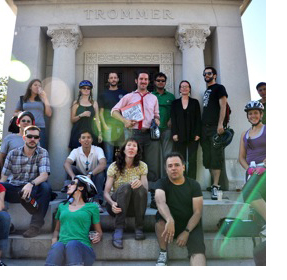-
Membership
Membership
Anyone with an interest in the history of the built environment is welcome to join the Society of Architectural Historians -
Conferences
Conferences
SAH Annual International Conferences bring members together for scholarly exchange and networking -
Publications
Publications
Through print and digital publications, SAH documents the history of the built environment and disseminates scholarshipLatest Issue:

-
Programs
Programs
SAH promotes meaningful engagement with the history of the built environment through its programsMember Programs
-
Jobs & Opportunities
Jobs & Opportunities
SAH provides resources, fellowships, and grants to help further your career and professional life -
Support
Support
We invite you to support the educational mission of SAH by making a gift, becoming a member, or volunteering -
About
About
SAH promotes the study, interpretation, and conservation of the built environment worldwide for the benefit of all
Brooklyn Breweries, by Bike
 Beer.
Beer.
You drink it. I drink it. Wikipedia proclaims it the world’s most widely consumed alcoholic beverage and suggests that it follows only water and tea in our collective liquid intake.
But what about breweries? They hardly appear in architectural histories. Participating recently in the Bike Brooklyn Beer Blitz got me thinking not only about this building type but also about the many modes and sites of historical research beyond the academy—the work of those amateur historians, enthusiasts, and other unpedigreed experts whose work intersects with that of professional historians to generate knowledge about architecture’s past.
Breweries have been in the news a lot lately, as they are now the frequent sites of adaptive reuse in cities throughout the industrialized world. Among the most prominent are London’s Truman Brewery, Copenhagen’s Carlsberg Town, Perth’s Swan Brewery, Shanghai’s Union Brewery, and Zurich’s Löwenbräu complex. Mostly, these disused industrial complexes have been turned into venues for the exhibition of art, though some contain art production spaces, housing, retail, office, or other programs.
There isn’t much when it comes to the history of breweries, however, beyond a few isolated accounts coming out of industrial archeology. The best sources turn out be home brewers, local history researchers, and tour guides--or at least one exemplary tour guide: Matt Levy , of Levys’ Unique New York. On a mild Sunday earlier this month I joined fifteen other cyclists for Matt’s four-hour bike tour of former breweries in the north Brooklyn neighborhoods of Williamsburg and Bushwick.
From the mid-19th-century to the mid-20th, these onetime Dutch townships hosted a dense concentration of breweries run largely by German immigrants, along with no small number of bars, beer halls, and beer gardens. We biked around the city, visiting empty, reprogrammed, and redeveloped sites once occupied by Schaefer, Rheingold, Fallert, Huber, Ulmer, and other brands. We also stopped at some of the churches these beermakers built. The tour culminated at the avenue of crisp granite mausoleums that constitutes “Brewer’s Row” at Evergreen Cemetery. And while the focus was historical, we didn’t fail to stop and sample the output of Sixpoint Craft Ales , Brooklyn Brewery , and other borough enterprises.
It was a fine time.
Some of the pleasure lay in finding historical insight infused with the affective charges that come from the physical activity of pedaling, the sensations of bicycle perception, and the metabolic enhancements of alcohol. Some came from the easy sociability of an ad-hoc cycling crew that mixed in different ways as we moved through different neighborhoods and tour stages. Some derived from the interactions the Blitz afforded me with architectural historians and history venues outside the nexus of universities and museums.
The Bike Brooklyn Beer Blitz was a work of passion and enterprise on the part of a Bushwick resident whose family business offers custom tours of New York City. It started at the City Reliquary , a storefront community museum that features oddball collections and offbeat events. Much of Matt’s information came from a 1976 volume self-published by Will Anderson, author of “From Beer to Eternity” among other titles. We were joined at the end by Donato Daddario , the Evergreen Cemetery gravedigger who has become the chief keeper of its history. And a television crew tracked us for a local cable show on Brooklyn businesses.
It was a pleasure to join this network of enthusiasts, entrepreneurs, and institutions brought together by their commitments to place and to its history. And, of course, to beer.


Leave a commentOrder by
Newest on top Oldest on top